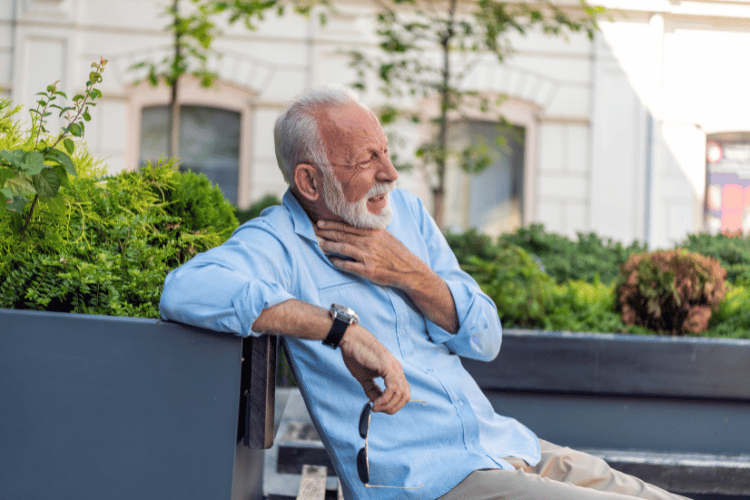
Choking is a medical emergency that can take a terrifying and critical turn in mere seconds. While many may know the basics of performing the Heimlich maneuver on a responsive choking victim, the situation becomes far more urgent and complex when the person loses consciousness. Knowing what to do in these critical moments can be the difference between life and death.
This guide provides an in-depth look at how to recognize a choking emergency, act quickly, and avoid common mistakes when helping someone who goes from responsive to unresponsive. Learn how to administer life-saving techniques like CPR, understand common pitfalls, and gain practical knowledge to handle such crises confidently.
Recognizing the Transition from Responsive to Unresponsive
The moment a choking victim becomes unresponsive marks a severe escalation in the emergency. Here are key signs to look out for:
Signs of Choking in Adults
- Clutching the throat with one or both hands, a universal choking gesture.
- Struggling to breathe, talk, or cough with possible wheezing or high-pitched sounds.
- Silent distress, as an entirely blocked airway may prevent any sound production.
- Changes in skin color, where the face may turn red initially and then pale or bluish.
- Loss of consciousness if the airway obstruction persists for too long.
Signs of Choking in Children
Children may exhibit different signs that are important to recognize:
- Coughing or gagging suddenly, particularly while eating or playing with small objects.
- Making high-pitched noises or no sound at all due to airway blockage.
- Distressed behavior, including crying or panicked gestures.
- Skin color changes, like redness that progresses to blue or pale.
- Limpness or fainting, in the absence of oxygen.
Remember: If a person can still cough or speak, encourage them to keep coughing to try dislodging the object. However, immediate action is required if they cannot make any sounds or are in visible distress.
Step-by-Step Guide: What to Do When a Choking Victim Becomes Unresponsive
When a choking victim stops responding, their survival depends on your quick response. Here’s a detailed step-by-step guide to assist an unresponsive choking person:
1. Call for Emergency Help Immediately
- If others are present, instruct someone to call 911 (or the local emergency number) immediately while you start first aid.
- If you’re alone, perform rescue actions for one minute before pausing to call for help.
2. Start CPR with Chest Compressions
- Lay the person flat on their back on a hard, stable surface.
- Place both hands at the center of the chest, just above the sternum.
- For an adult, perform 30 strong chest compressions at a rate of 100–120 beats per minute, pressing about 2 inches deep.
- Unlike standard CPR, do not focus on rescue breaths yet; the airway must be cleared first.
3. Check the Mouth for Blockages After Each Set of Compressions
- After 30 compressions, open the person’s mouth and look for the obstructing object.
- If visible, carefully remove it using a hooked finger to sweep it out. Do not perform a blind finger sweep, as it might push the object further down.
4. Attempt Rescue Breaths If the Airway Clears
- If you successfully remove the object, give two rescue breaths by sealing your mouth over theirs, pinching their nose, and exhaling into their mouth.
- Watch for visible chest rise. If the chest doesn’t rise, the airway is still blocked; return immediately to chest compressions.
5. Continue Until Help Arrives or the Person Regains Consciousness
- Repeat the sequence of 30 compressions → check mouth → rescue breaths (if possible).
- If the victim regains consciousness and breathing, place them in recovery and monitor them until professional help arrives.
Why It Works:
- Chest compressions exert pressure that may dislodge a blockage, similar to the Heimlich maneuver.
- Even if the airway remains blocked, compressions deliver vital blood flow, delaying brain damage.

When a Choking Victim Becomes Unresponsive
Common Mistakes to Avoid When Helping a Choking Victim
Even well-meaning individuals can sometimes worsen the situation due to a lack of training or panic. Here are some common mistakes to avoid:
Mistakes During the Heimlich Maneuver
- Misplacement of hands can reduce the maneuver’s effectiveness and risk injury. Always place hands just above the navel, below the ribcage.
- Excessive or insufficient force in abdominal thrusts can cause harm or fail to expel the object.
- Performing abdominal thrusts on someone who isn’t choking or unconscious can cause unnecessary injuries.
Errors While Performing CPR
- Incorrect hand placement or depth of compressions can harm the victim. Ensure compressions are at least 2 inches deep but not overly forceful.
- Maintaining an improper compression rhythm (too fast or too slow) limits effectiveness. Aim for 100–120 compressions per minute.
- Skipping airway checks between compressions risks leaving the blockage in place.
Ignoring Signs of Severe Distress
Failing to act quickly when the victim shows blue lips, silent distress, or unconsciousness can have fatal consequences. Prompt intervention is critical.
Attempting a Finger Sweep Blindly
Sweeping the mouth without seeing the object can push the blockage deeper into the airway, making it harder to remove.
Avoiding these mistakes and using proper techniques increases the chances of a positive outcome.
When to Call for Help and What to Say?
When a choking emergency arises, knowing when and how to engage emergency services is essential.
Timing
Call 911 immediately if:
- The person cannot cough, speak, or breathe.
- They lose consciousness or stop responding.
- Choking persists even after attempts to dislodge the object.
Communicating with Responders
Provide helpful details:
- Exact location, including landmarks.
- Victim’s condition, such as age, responsiveness, or color changes.
- Actions already taken, like using the Heimlich maneuver or starting CPR.
Staying calm allows emergency responders to arrive prepared and equipped for the situation.
The Importance of CPR and First Aid Training
CPR and first aid training can empower individuals to handle choking emergencies effectively. Many organizations, including the Red Cross, offer courses on these life-saving techniques. Regularly refreshing your knowledge ensures you’re ready to act confidently under pressure.
Benefits of Training:
- Clear understanding of the proper techniques for CPR and Heimlich maneuver.
- Confidence to act quickly in emergencies.
- Ability to recognize symptoms and avoid common mistakes.
Investing in first aid education is not just a personal skill but a communal one that could save lives.
Frequently Asked Questions (FAQ)
Q: What should I do if a responsive choking adult becomes unresponsive?
A: If a responsive choking adult becomes unresponsive, gently lower them to the ground. Then, call for emergency assistance. Begin CPR immediately, starting with chest compressions.
Q: How can I recognize a choking adult?
A: A choking adult may display signs such as clutching their throat, inability to speak, and distress. They may also turn blue or lose consciousness if the airway remains blocked.
Q: What is the Heimlich maneuver, and how is it performed on a choking adult?
A: The Heimlich maneuver involves standing behind the choking adult, placing your arms around their waist, making a fist with one hand, and placing the thumb side against the person's abdomen, just above the navel. You then grasp your fist with the other hand and perform quick inward and upward thrusts.
Q: What should I do if the choking adult is still conscious but unable to breathe?
A: If the choking adult is still conscious but unable to breathe, you should give back blows and abdominal thrusts. Stand behind the person, and give five back blows followed by five abdominal thrusts until the object is expelled or the person becomes unresponsive.
Q: How do I perform chest thrusts on a choking adult?
A: To perform chest thrusts on a choking adult, place your hands on the person's chest, and use the heel of your hand to push inward and upward, aiming to force the object out. This method is beneficial if the person is pregnant or obese.
Q: What steps should be taken if the person becomes unconscious?
A: If the person becomes unconscious, you should lower them to the ground, call for emergency services, and begin CPR. Start with chest compressions and check the mouth for any visible obstruction. If you see an object, attempt a finger sweep to remove it.
Q: Should I give breaths during CPR for a choking adult?
A: Yes, after performing chest compressions during CPR for a choking adult, you should attempt to give breaths. However, if the airway is still blocked, you may not be able to provide breaths successfully. Continue with chest compressions and checks for obstruction.
Q: Can I use choking flashcards to help in a choking emergency?
A: Yes, choking flashcards can be a valuable tool for training and reminding yourself of the steps to take during a choking emergency. They can help reinforce the procedures for effectively responding to a choking adult.
Q: Is calling the Red Cross in a choking emergency necessary?
A: While calling the Red Cross during a choking emergency is unnecessary, it is important to contact emergency services immediately if the situation escalates or the person becomes unresponsive. The Red Cross can provide training and resources for choking first aid.
The Bottom Line
Choking emergencies can escalate into life-threatening situations in seconds, but knowledge and swift action can make all the difference. Recognizing the signs of choking, administering proper first aid, and avoiding common mistakes puts you in the best position to save a life.
Empower yourself with CPR and first aid training, and share this guide widely—it might be the lifeline someone desperately needs. Remember, when every second counts, clear thinking and immediate action can save a life.








 Login with Google
Login with Google Login with Facebook
Login with Facebook